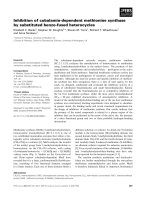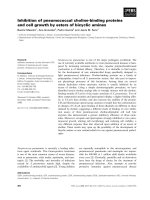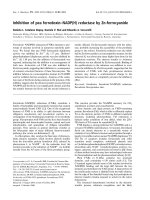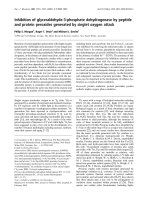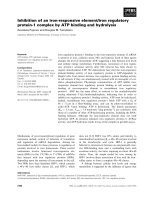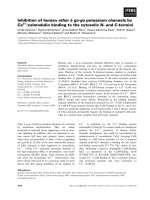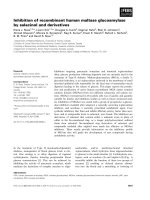Báo cáo khoa học: Inhibition of Drosophila melanogaster acetylcholinesterase by high concentrations of substrate potx
Bạn đang xem bản rút gọn của tài liệu. Xem và tải ngay bản đầy đủ của tài liệu tại đây (339.89 KB, 8 trang )
Inhibition of
Drosophila melanogaster
acetylcholinesterase by high
concentrations of substrate
Jure Stojan
1
, Laure Brochier
2
, Carole Alies
2
, Jacques Philippe Colletier
2
and Didier Fournier
2
1
Institute of Biochemistry, Medical Faculty, University of Ljubljana, Slovenia;
2
IPBS-UMR 5089, Toulouse, France
Acetylcholine hydrolysis by acetylcholinesterase is inhi-
bited at high substrate concentrations. To determine the
residues involved in this phenomenon, we have mutated
most of the residues lining the active-site gorge but
mutating these did not completely eliminate hydrolysis.
Thus, we analyzed the effect of a nonhydrolysable sub-
strate analogue on substrate hydrolysis and on reactiva-
tion of an analogue of the acetylenzyme. Analyses of
various models led us to propose the following sequence
of events: the substrate initially binds at the rim of the
active-site gorge and then slides down to the bottom of
the gorge where it is hydrolyzed. Another substrate
molecule can bind to the peripheral site: (a) when the
choline is still inside the gorge – it will thereby hinder its
exit; (b) after choline has dissociated but before deacety-
lation occurs – binding at the peripheral site increases
deacetylation rate but (c) if a substrate molecule bound to
the peripheral site slides down to the bottom of the active-
site before the catalytic serine is deacetylated, its new
position will prevent the approach of water, thus blocking
deacetylation.
Keywords: acetylcholinesterase; deacylation; inhibition; kin-
etics; structure-function.
Cholinesterases [acetylcholinesterases, (AChEs) and buty-
rylcholinesterases] are serine hydrolases that hydrolyze
choline esters in two steps: acylation of the enzyme,
followed by deacylation involving a water molecule [1].
In the case of AChEs, the process takes place at the
acetylation site, located at the bottom of a 20 A
˚
-deep
gorge, usually called the active-site gorge. The site includes
a tryptophan residue that interacts with the trimethyl-
ammonium group of acetylcholine, and a serine residue
which is acetylated and hydrolyzed in the course of
substrate turnover [2,3].
Kinetic studies of Drosophila AChE (DmAChE) have
revealed an atypical behavior, with both apparent activation
at low substrate concentrations and inhibition at high
substrate concentrations [4]. It was established that kinetics
result from only one enzymatic form, regulated by the
substrate itself [5]. The substrate activation site was located
using a competitive inhibitor of activation, Triton X-100,
and mutated enzymes. It appeared that the activation site is
located at the rim of the active-site gorge [6]. Binding of
a substrate molecule at the activation site increases the
deacetylation [7] and thereby cleans up the active-site gorge
before sliding to its entrance. Additionally, binding of a
substrate molecule at the rim of the gorge may participate in
correctly orienting positively charged substrates, with a view
to their sliding down to the bottom of the gorge in the most
favorable conformation. It would thus contribute to cata-
lytic efficiency by transiently binding the substrate molecules
on their way to the acetylation site [8–10].
Two kinds of evidence suggested localization of the
substrate inhibition site at the rim of the gorge. First,
substrate at high concentration was found to compete with
ligands specific for the peripheral site [11–13]. Second, some
mutations located at the rim of the gorge are known to
affect substrate inhibition [14,15]. However, mutations of
some other residues constituting the peripheral site did not
influence substrate inhibition [16–18], while mutation of
some residues located at the bottom of the active-site did.
This led us to revive an old hypothesis whereby substrate
inhibition results from substrate binding to the acetylated
enzyme [19,20]. Thus, in the present paper, we explored the
inhibition phenomenon occurring in the DmAChE, for
a fuller understanding of its mechanism and to locate the
site of this regulation.
Experimental procedures
Enzyme sources
Truncated Drosophila melanogaster cDNA encoding sol-
uble AChEs, wild-type and mutated, were expressed with
the baculovirus system [21]. Secreted AChEs were purified
and stabilized with 1 mgÆmL
)1
BSA as reported previously
[22]. The concentration of the enzymes was determined by
active-site titration using 7-(methylethoxyphosphinyloxy)-
1-methylquinolinium iodide, a high-affinity phosphorylat-
ing agent [23]. Residue numbering is given according to the
sequence of the mature DmAChE [3,24]; the corresponding
numbering in the Torpedo AChE sequence is shown in
Table 1.
Correspondence to D. Fournier, IPBS-UMR 5089,
205 Route de Narbonne, F-31077 Toulouse, France.
Fax: +33 5 61 17 59 94, Tel.: +33 5 61 55 54 45,
E-mail:
Abbreviations: AChE, acetylcholinesterase; ATCh, acetylthiocholine;
DmAChE, Drosophila AChE.
(Received 24 September 2003, revised 20 January 2004,
accepted 23 February 2004)
Eur. J. Biochem. 271, 1364–1371 (2004) Ó FEBS 2004 doi:10.1111/j.1432-1033.2004.04048.x
Chemicals
Acetylcholine, acetylthiocholine (ATCh), were purchased
from Sigma. Carbaryl, 1-naphthylmethylcarbamate, was
purchased from Cil Cluzeau Info Labo (Sainte-Foi-
La-Grande, France) and the substrate analogue, 4-ketoamyl
trimethyl ammonium iodide was purchased from MP
biochemicals ( (Fig. 1).
Kinetics of substrate hydrolysis
Kinetics were followed at 25 °Cin25 m
M
phosphate buffer,
pH 7, 1 mgÆml
)1
BSA, at low and high ionic strength
(substrate + NaCl at 300 m
M
). Hydrolysis of ATCh iodide
was followed spectrophotometrically at 412 nm using the
method of Ellman et al. [25], at substrate concentrations
ranging from 2 l
M
to 300 m
M
, in 1 cm path length cuvettes.
Activity was measured for 1 min after addition of the
enzyme to the mixture, and spontaneous hydrolysis of
substrate was subtracted. Data were analyzed by multiple
nonlinear regression. The values for the optimum activity,
and inflexion point leading to total inhibition were
calculated numerically by taking the first and the second
derivatives, respectively, of theoretical pS curves. They were
obtained by fitting the equation of the rational fourth degree
polynomial to the initial rate data of each mutant because
such a polynomial was the equation with the lowest
complexity to describe the wild-type pS curve. As only data
for substrate hydrolysis were available for the mutated
enzymes, reaction steps could not be estimated due to
correlations between parameters.
Determination of the decarbamoylation rate constant
of AChE
Enzyme was incubated at 25 °C with 0.1 m
M
carbaryl in
25 m
M
phosphate buffer, pH 7, 1 mgÆmL
)1
BSA until more
than 95% of the enzyme was inhibited. The mixture was
loaded on a gel filtration column (P10, Pharmacia) and
eluted with 25 m
M
phosphate buffer, pH 7, 1 mgÆmL
)1
BSA. Fractions with enzyme were collected. The decarb-
amoylation rate of the enzyme was studied in the presence
of different concentrations of substrate analogue (from
10 l
M
to 100 m
M
), at 25 °C, in 25 m
M
phosphate buffer,
pH 7, 1 mgÆmL
)1
BSA with or without NaCl (substrate
analogue + NaCl at 300 m
M
).Thedegreeofdecarbamoy-
lation was followed for 9 h by sampling aliquots of the
reaction mixture and estimating free enzyme concentration
spectrophotometrically by its activity against 10 m
M
ATCh.
The reactivation could be described by a simple first-order
rate equation. The decarbamoylation rate constant (kr), was
calculated by nonlinear regression analysis using Eqn (1):
½E
t
¼½Ec
0
ð1 À e
Àkr: t
Þþ½E
0
ð1Þ
where [E]
t
represents the free enzyme concentration at time
t,[E]
0
theinitialconcentrationoffreeenzymeand[Ec]
0
the initial concentration of mono-methylcarbamoylated
enzyme.
Results
Location of residues involved in substrate inhibition
To determine the residues involved in inhibition by excess
substrate, we employed in vitro site-directed mutagenesis of
residues lining the active-site gorge. These positions were
changed to various amino acids (Table 1) with the previous
objective of engineering an AChE, sensitive to insecticides,
which could be used to detect residuals in the environment
Table 1. Substrate concentrations (mmolÆL
)1
) at which the optimum and
the inflection point at the inhibition part of pS curve are reached in the
wild-type and in various DmAChE mutants. The number corresponds to
the sequence of the mature protein and the number in parenthesis
corresponds to the Torpedo numeration. (Bold, pS curves of mutants
shown in Fig. 2.)
Mutant Optimum
Inflexion
point Mutant Optimum
Inflexion
point
Wild-type 1.19 38.6 W321(279)A 5.01 50.6
E69(70)A 1.23 40.8 W321(279)L 6.17 26.1
E69(70)I 0.98 39.9 Y324(282)A 0.79 46.3
E69(70)L 1.72 40 L328(288)A 1.08 54.8
E69(70)K 6.19 88 L328(288)F 1.76 40.7
E69(70)W 1.38 98.7 F330(290)A 3.20 117.4
E69(70)Y 2.65 22.1 F330(290)C 1.68 132.5
R70(71)V 12.92 85.7 F330(290)G 4.31 23
Y71(72)A 2.69 58.4 F330(290)H 1.25 20.5
Y71(72)D 7.4 175 F330(290)I 1.44 85.8
Y71(72)K 5.47 25.6 F330(290)L 1.54 15.2
Y73(74)A 0.97 59.7 F330(290)S 2.52 19.7
Y73(74)Q 1.86 69 F330(290)V 2.85 36.6
F77(78)S 3.25 39.7 F330(290)W 4.01 49.8
W83(84)A 16 218 F330(290)Y 2.86 35.2
W83(84)E 32 144 G368(328)A 3.33 57.3
W83(84)Y 1.83 26.3 Y370(330)A 4.66 99.5
M153(129)A 2.01 81.7 Y370(330)C 31.65 1114
I161(137)K 1.15 47.2 Y370(330)F 0.69 117.7
I161(137)T 0.48 3.7 Y370(330)L 4.67 32.5
Y162(138)A 21.1 85.1 Y370(330)P 4.01 245.5
V182(158)L 1.25 72.7 Y370(330)S 1.88 152
E237(199)A 5.3 129.4 F371(331)A 3.07 19.8
E237(199)G 7.34 112.3 F371(331)G 3.37 68.4
E237(199)Q 2.25 31.3 F371(331)Y 8.76 308.9
G265(227)A 2.72 74.5 Y374(334)A 1.52 68.2
W271(233)G 13.2 185.1 D375(335)G 1.19 49
V318(276)A 1.26 39.2 D375(335)A 1.74 22.7
V318(276)D 1.43 61.4 D375(335)d 2.87 40.7
Fig. 1. Chemical formulae of the compounds used.
Ó FEBS 2004 Substrate inhibition of acetylcholinesterase (Eur. J. Biochem. 271) 1365
[26,27]. All the enzymes analyzed exhibited more than
5% of the wild-type DmAChE activity, including active-
site tryptophan mutants (Trp83). In all the mutants, we
observed inhibition at high substrate concentration as
evidenced by the existence of optima and inflexion points
(Table 1). For comparison, substrate concentrations at the
inflexion points represent approximately the values of Kss
estimated by using the Haldane equation [28]. Even the
enzymes with substitution at positions 71, 237 or 370 were
inhibited (Fig. 2A), whereas analogous mutants in verteb-
rate AChE were not [15,29]. However, in some cases (Y71D,
W83E and Y370C), we observed a shift of inhibition
towards higher substrate concentrations (Fig. 2B). Inhibi-
tion appears to be total, although, with some mutants,
we observed relatively high activity even at the highest
substrate concentration used (0.3
M
).
Inhibition of the decarbamoylation rate by excess
substrate analogue
There are several hypotheses that can explain inhibition
by excess substrate. One of them is a decrease of the
deacetylation rate upon binding the substrate molecule to
the acetylated enzyme [19]. If this were so, a decrease of the
decarbamoylation rate would be expected at high substrate
concentrations. To test this hypothesis, we measured the
decarbamoylation rate of the wild-type enzyme in presence
of substrate analogue (Fig. 1) at concentrations ranging
from 0 to 100 m
M
. The analogue was used instead of
the substrate to avoid decarbamoylation due to transcarb-
amoylation by the choline, generated from the substrate
hydrolyzed by the noncarbamoylated fraction of the
enzyme. Figure 3 shows activation of the decarbamoylation
rate at low substrate analogue concentrations as reported
already [7], followed by the inhibition at high concentra-
tions. The same pattern was found in the presence of
300 m
M
NaCl showing that increased ionic strength at high
substrate concentrations does not influence activation and/
or inhibition (diagram not shown).
Inhibition of substrate hydrolysis by substrate analogue
To get additional information on inhibition by excess
substrate, we analyzed the inhibition of substrate hydrolysis
by the substrate analogue (Fig. 3B). As expected, the
addition of substrate analogue affects activity at low
substrate concentrations and has virtually no effect at
high substrate concentrations. Moreover, a decrease and
displacement of the optimum towards higher substrate
Fig. 2. pS-curves for ATCh hydrolysis by: (A) E237Q, Y71K and
Y370A mutants; (B) W83E, Y71D and Y370C mutants at low ionic
strength. The curves are theoretical, obtained by fit of the equation of
rational fourth degree polynomial to the data.
Fig. 3. Inhibition of decarbamoylation and substrate hydrolysis by sub-
strate analogue. (A) Decarbamoylation rate of wild-type DmAChE as
a function of different concentrations of substrate analogue (values are
the average of at least five independent measurements). (B) pS-curves
for ATCh hydrolysis by wild-type AChE in the presence of different
concentrations of substrate analogue. The curves are theoretical,
obtained by simultaneous fit of the two equations to the data (substrate
hydolysis and decarbamoylation in presence of substrate analogue).
1366 J. Stojan et al. (Eur. J. Biochem. 271) Ó FEBS 2004
concentrations was observed with increasing analogue
concentrations.
In order to interpret the effects of substrate analogue on
decarbamoylation and ATCh hydrolysis, we tested several
kinetic models, all taking into account the existence of the
Michaelis complex and the acetylated-enzyme. The simplest
model, which gave satisfactory results, is presented in Fig. 4.
It is based on two assumptions: (a) two substrates (or
substrate analogues) molecules can bind simultaneously to
the free and the acetylated enzyme as shown by structural
studies [30] and (b) the occupation of the anionic subsite at
the bottom of the active-site blocks deacetylation as shown
by our decarbamoylation experiment and as supported by
structural studies of soman aged human butyrylcholin-
esterase [31].
Following this model, the substrate initially binds to the
peripheral site, mainly consisting of Trp321, at the entrance
of the active-site gorge, thereby giving the complex SpE.
Gliding down the gorge to the catalytic site results in
formation of a Michaelis addition complex (ES), thus
setting free the peripheral site for another substrate molecule
to give a ternary complex (SpES). The enzyme is acetylated
to yield the acetylated enzyme EA (and SpEA), and during
this step, choline is released. During the next step, a water
molecule approaches the esteratic bond and induces
deacetylation to regenerate the free enzyme (E). Binding
of another substrate molecule to the peripheral site of the
Michaelis complex, leading to SpES, reduces acetylation of
the catalytic serine (b<1, Fig. 4). This binding indeed blocks
the choline exit after the breakdown of the substrate; the
choline is reacetylated, and as result, the overall acetylation
process is slowed down. Ligand binding at the peripheral
site of the acetylated enzyme enhances the approach of
water and increases deacetylation (a>1, Fig. 4). However,
the substrate molecule bound to the peripheral site can also
enter deeper in the gorge of the acetylated enzyme (K
LL
)
thus giving the EAS complex. At this stage, no water
molecule can draw near to the esteratic bond and, in
consequence, the substrate molecule completely blocks
deacetylation. Finally, if another substrate molecule binds
to the peripheral site, a ternary complex between acetylated
enzyme and two substrate molecules is formed (SpEAS)
(visualization in Fig. 5). A substrate analogue can substitute
for the substrate in all but the chemical steps, with different
binding affinities due to the replacement of the oxygen atom
by a methylene group.
The results were evaluated by fitting simultaneously the
equation for decarbamoylation and the derived steady-state
equation to the two different data sets: decarbamoylation
rate data and initial rate data in the absence and presence
of substrate analogue (Fig. 3). In this analysis, we treated
binding and gliding steps as if in equilibrium, thus, using
mixed equilibrium and steady-state assumptions. This
solution was first applied for the analysis of decarbamoy-
lation because it is very slow. The evaluated constants are
therefore true equilibrium constants. Later, when we tested
the model for substrate hydrolysis using pure nonequilib-
rium assumptions, we were able to obtain a value for the
substrate analogue peripheral site binding constant (K
ip
),
which was identical to the value estimated from decarb-
amoylation experiments only by setting association and
dissociation rate constants in the range compatible with
equilibrium treatment. The results obtained with this model
are listed in Table 2. It was possible to find another
satisfactory solution. For the discrimination, we used two
criteria: a solution should first give a low residual least
Fig. 4. Reaction scheme for the hydrolysis of ATCh. Erepresentsthe
free AChE, EA the acetylated enzyme and S the substrate. When a
ligand is bound to the peripheral site, it is written on the left of E with
the subscript ÔpÕ added (S
p
E). When a ligand is bound at the catalytic
site, the symbol is written on the right of E (ES). Per analogiam, SpEAS
means that a substrate molecule is at the peripheral site and another
substrate molecule at the acylation site of acetylated enzyme.
Fig. 5. 3D-visualization of the SpEAS complex in the active-site of wild-
type Drosophila melanogaster AChE. Substrate molecules at the bot-
tom of the gorge and at the peripheral site are in green and in yellow,
respectively. Dark blue, red and light blue atoms represent nitrogen,
oxygen and carbon, respectively; oxygen atoms of water molecules are
in gold; white atoms represent the acyl moiety of the Ser238. Position
of the ligands was modelled according to the position of decameto-
nium trimethylamonium groups [49]. The structure was optimized
using mixed quantum and molecular mechanic algorithms using
CHARMM
, where the two substrate molecules, acetate and active serine
residue were treated quantum mechanically [51].
Ó FEBS 2004 Substrate inhibition of acetylcholinesterase (Eur. J. Biochem. 271) 1367
square sum, and second, yield similar values for the
substrate and the substrate analogue kinetic parameters
regarding the most putative reaction steps. The solution
presented in Table 2 fulfils both criteria, except for the value
of K
L
. A logical explanation is that the substrate analogue
binds tightly to the oxyanion hole [30], while the substrate at
the same position will be cleaved; hence the partition
coefficient of the substrate (K
L
) represents also the propor-
tion of nonproductive substrate orientations in the gorge.
Additionally, we can note that the analogue is more
hydrophobic than the substrate itself and will thereby bind
more tightly to the aromatic gorge.
Discussion
We here propose a model for the reaction mechanism that
explains inhibition by excess of substrate in cholinesterases.
Our main assumption is that the binding of a substrate
molecule to the acetylated enzyme, within the active-site
gorge, blocks deacetylation by sterically hindering the access
of water to the esteratic bond. This mechanism is additional
to the blockade of choline exit by a substrate bound at the
peripheral site. We have tested this hypothesis with D. mel-
anogaster AChE, which displays, at intermediate substrate
concentrations, higher activities than would be expected for
a Michaelis–Menten mechanism, and which can, also, be
completely inhibited by excess of substrate.
Location of the substrate inhibition site
It has been suggested that the inhibition binding site could
be located at the rim of the active-site gorge, at a site called
the Ôperipheral anionic siteÕ. The first support for this
assumption came from the identification of a peripheral
binding site for noncompetitive inhibitors such as
propidium and fasciculin. High concentrations of acetyl-
choline, causing substrate inhibition, affects the binding of
these two ligands, indicating that the substrate inhibition
binding site, and the propidium and the fasciculin-binding
sites overlap [11,16]. The second argument in favour of
the location of the inhibition binding site at the rim of the
active-site gorge came from in vitro mutagenesis experi-
ments. Shafferman et al. [15] found that some mutations
attherimofthegorgecouldgenerateenzymesinwhich
inhibition by high substrate concentrations was partially or
completely eliminated, leading to the hypothesis that
peripheral and substrate inhibition sites would overlap.
However, some data suggest that the inhibition binding
site might not be located at the rim of the active-site gorge.
From recent competition experiments with fasciculin, the
affinity of acetylcholine for the peripheral anionic site of
human erythrocyte AChE has been estimated to be 1 m
M
,
a dissociation constant that corresponds numerically to
the optimum activity [32] and not to the inhibition. With
DmAChE, substitution of residues located at the rim of the
gorge did not change the inhibition by excess substrate, even
when mutating the residues which were involved in the
binding site of Triton X-100,
D
-tubocurarine and propi-
dium, i.e. residues Glu69, Asp375 and Trp321, respectively.
This result is in agreement with the observation of substrate
inhibition phenomenon on chicken AChE, which lacks a
propidium binding site [18], and with site-directed muta-
genesis data on mouse and Bungarus fasciatus AChEs:
mutations which drastically affect the binding of propidium
do not affect inhibition by excess substrate [17,33].
A logical possibility is that substrate inhibition originates
from the bottom of the active-site. Some mutations located
in this region have already been identified as influencing
the inhibition by excess substrate. Torpedo E199Q AChE,
mouse F297I AChE and human Y337A AChE were not
inhibited at high substrate concentrations [15,28,34]. In
DmAChE, mutations of Trp83 and Tyr370, which are
located at the bottom of the gorge and play a key role in the
recognition of the quaternary ammonium moiety of ACh,
show significant shift of inhibition towards higher concen-
trations (Fig. 2B). According to all these results, substrate
inhibition involves different residues lining the active-site
gorge, from the top to the bottom, and disruption of only a
part of this gorge by in vitro mutagenesis cannot completely
eliminate substrate inhibition. Thus, substrate inhibition
seems to be a general property of buried active-sites
(cf. alcohol dehydrogenase [35]), more pronounced with
the narrowness of the site: weak in butyrylcholinesterase
with a large active-site and strong in DmAChE with a
narrow active-site.
Substrate inhibition originates from the inhibition of the
deacetylation rate and from steric hindrance of product
exit – the first hypothetical mechanism was expounded in
the sixties after the existence of an acetylenzyme interme-
diate was proposed. It was postulated by Krupka and
Laidler that inhibition of AChE by substrate resulted from
the inhibition of deacetylation [19]. This would arise from
the combination of acetylcholine with the acetylenzyme
at the anionic site at the bottom of the gorge, which is set
free after the release of the choline. Such a binding would
prevent deacetylation of the acetylenzyme by hindering the
approach of a water molecule to the acetylated serine. By
showing that acetylcholine and some reversible inhibitors
block decarbamoylation, Wilson and Alexander supported
this theory [36]. The determination and the comparison of
acetylation and deacetylation rate constants, again, upheld
this hypothesis. Indeed, the deacetylation rate is lower than
the acetylation rate and there is a substantial steady-state
Table 2. Values of individual kinetic constants obtained by the simul-
taneous fit of equations, derived from reaction schemes presented in
Fig. 4, to the data for the inhibition of substrate hydrolysis and decarb-
amoylation by the substrate analogue.
Constant Substrate
Substrate
analogue
Carbamoyl
enzyme
k
2
(s
)1
) 19400 ± 4400 – –
k
3
(s
)1
) 400 ± 50 – 138 ± 6 10
)6
K
p
(l
M
) 190 ± 30 100 ± 20 –
K
L
1 ± 0.4 0.044 ± 0.013 –
K
LL
130 ± 30 75 ± 20 –
a 4.2 ± 0.5
a
2.5 ± 0.1
a
2.5 ± 0.1
b
b 0.16 ± 0.02
c
0.15 ± 0.05
c
–
a
Acceleration of deacetylation by substrate and substrate ana-
logue.
b
Acceleration of decarbamoylation by substrate analogue.
Acceleration of deacetylation and decarbamoylation by substrate
analogue were fitted together.
c
Inhibition of acetylation by sub-
strate analogue.
1368 J. Stojan et al. (Eur. J. Biochem. 271) Ó FEBS 2004
level of acetylated enzyme for marked substrate inhibition
to occur [31,37]. Our results are in accordance with this
mechanism as we observed inhibition of the decarbamoy-
lation rate by high concentrations of substrate analogue
(Fig. 3). The existence of another mechanism for substrate
inhibition has been proposed by the group of T.L.
Rosenberry. They have suggested that substrate inhibition
occurs from a steric hindrance created by product exit when
another molecule is bound to the peripheral site [38]. Careful
inspection of the pS curve for DmAChE (Fig. 3) shows two
different components in the inhibition, one at substrate
concentrations just above optimum and the other at very
high substrate concentrations. Thus, we attributed the two
components of the curve to the two substrate inhibition
mechanisms of the proposed scheme (Fig. 4), steric hin-
drance of the choline exit and blockade of deacetylation,
respectively.
Substrate at the peripheral site does not completely
block the exit of choline reinforcing the hypothesis
of the existence of a backdoor
Results obtained by the analyses of our data also suggest
that there is only a partial blocking of choline exit. The value
of b ¼ 0.15 is significantly different from zero and reflects
the blocking of choline exit by the substrate molecule bound
at the peripheral site. If choline remains blocked at the
bottom of the gorge, the reverse reaction occurs, the choline
is acetylated and the apparent deacetylation is reduced [39].
This partial blocking might reflect an alternative way for the
exit of choline by a backdoor, as proposed with analogy to
lipase [40]. At least two pieces of experimental evidence
support the backdoor hypothesis: the change of acrylodan
fluorescence spectra of distinctive omega-loop sites in mouse
AChE [41] and the absence of the eseroline leaving group in
the crystallographic view of the fully occupied carbamoyl-
ated gorge of TcAChE [42]. Furthermore, the existence of
such rapid omega-loop movements could also permit the
entrance of the substrate, as supported by simulation [40]
and by the residual activity of vertebrate AChEs in presence
of great excess of fasciculin, which completely covers the
main entrance of the active-site [43–45]. The value of b is
small, suggesting that the exit of product by the back door
constitutes only a low proportion of the traffic. This would
explain why closing the backdoor with ionic or covalent
bonds did not result in a significant change of catalytic
activity [46,47].
Effect of occupying the peripheral site on the binding
of ligands at the catalytic site
Binding of a ligand to the peripheral site most probably
affects the affinity of ligands at the catalytic site. It was shown
that bound propidium or gallamine decreased association
and dissociation rate constants for both acylation site ligands
and for substrate [38]. Similarly, we observed a decrease of
phosphorylation rate by hemi-substrates in the presence of
peripheral ligands such as Triton X-100 and propidium [6,7].
However, it was found in cholinesterases from various
species, that small hemi-substrates are enhanced in their
association with active serine in the presence of bulky
peripheral ligands such as propidium and
D
-tubocurarine:
the entrance rate of small substrates, such as methamido-
phos, aldicarbe or methanesulfonylfluoride, is reduced but
much less than their exit rate, resulting in increased affinity
[46,48]. In other words, it appears that occupation of the
peripheral site decreases the affinity for large ligands and
increases the affinity for small ones.
Upon binding of a substrate molecule to the peripheral
site, the same explanation should also apply to the water
molecule involved in deacetylation, as this water can then be
considered as a small substrate. Up to 1 m
M
,increasing
concentrations of substrate analogue increases the decarb-
amoylation rate. The binding of the substrate analogue,
at the peripheral site, might increase the probability for
the water molecule to reach the productive position for
hydrolysing the esteratic bond. In the model, the factor ÔaÕ
represents the enhanced probability of water approach to
the carbamoylated or acetylated serine. It is larger than one,
when the active-site gorge accessibility is hampered by a
ligand at the peripheral site. This can be explained in terms
of transition state theory as follows. It is believed that water
molecules in the active-site of cholinesterases are cluster-
oriented. A ligand binding to the peripheral site disrupts this
cluster. Consequently, one part of the water molecule is
released in bulk, but the second part is captured below the
ligand in a newly formed cavity. The entropy gain,
accounted for by the first part is used to combine acetylated
enzyme complex with one of the captured water molecules.
The energetic cost of immobilizing the Ôactive waterÕ, i.e. the
lowering of the barrier, is thus provided by those which are
released. It can be estimated easily that a fourfold increase in
deacetylation rate (% 3.5 kJÆmol
)1
at 298K) can be gained
by the release of only one water molecule of hydration
immobilized in a crystal or mineral (between zero and
8.3 kJÆmol
)1
at 298K) [50]. This hypothesis is in accordance
with the observation of Harel et al. [51] on the complex
structure of TcAChE with TMTFA, a transition state
analogue of ACh. Indeed, upon binding of this compound,
six water molecules found in the native structure are
displaced. The authors state that the dry and confined
environment in which the transition state forms could be
responsible for the high catalytic power of AChE. Upon
binding of a ligand to the peripheral site, the active-site
gorge of AChE gets virtually full and the probability for
the water to reach its productive position for hydrolysis of
the esteratic bond will increase, given the confinement and
the low water content of the gorge. In kinetic terms, the
binding of a substrate molecule to the peripheral site
increases the ÔaffinityÕ of the active water molecule for
the acetylated catalytic serine, by capturing water molecules
at the bottom of the gorge.
In conclusion, our data suggest that the peripheral site
is only partially responsible for the inhibition by excess
substrate in DmAChE. According to the proposed reaction
scheme, the substrate always binds at the peripheral site and
then slides to the bottom where it is hydrolyzed. When the
catalytic site is acetylated, the binding at the peripheral site
closes the gorge, resulting in an increased deacetylation by
enhancing the affinity of the water molecule involved in
catalysis; if the substrate molecule slides down the gorge to
the active-site before the catalytic serine is deacetylated, its
new position at the bottom then blocks the deacetylation
(Fig. 5).
Ó FEBS 2004 Substrate inhibition of acetylcholinesterase (Eur. J. Biochem. 271) 1369
Acknowledgements
This research was supported by grants from CEE (ACHEB, QLK3-
CT-2000–00650 and SAFEGUARD, QLK3-CT-2000–000481) and
from DGA (PEA 99CO029).
References
1. Wilson, I.B. & Cabib, E. (1956) Acetylcholinesterase: enthalpies
and entropies of activation. J. Am. Chem. Soc. 78, 202–207.
2. Sussman, J.L., Harel, M., Frolow, F., Oefner, C., Goldman, A.,
Toker, L. & Silman, I. (1991) Atomic structure of acetylcho-
linesterase from Torpedo californica: a prototypic acetylcholine-
binding protein. Science 253, 872–879.
3. Harel, M., Kryger, G., Rosenberry, T.L., Mallender, W.D., Lewis,
T., Fletcher, R.J., Guss, J.M., Silman, I. & Sussman, J.L. (2000)
Three-dimensional structures of Drosophila melanogaster acetyl-
cholinesterase and of its complexes with two potent inhibitors.
Protein Sci. 9, 1063–1072.
4.Marcel,V.,Gagnoux-Palacios,L.,Pertuy,C.,Masson,P.&
Fournier, D. (1998) Two invertebrate acetylcholinesterases show
activation followed by inhibition with substrate concentration.
Biochem. J. 329, 329–334.
5. Estrada-Mondaca, S., Lougarre, A. & Fournier, D. (1998) Modi-
fication of the primary sequence of Drosophila melanogaster
acetylchoplinesterase to increment in vitro expression. Arch. Insect.
Biochem. Physiol. 38, 84–90.
6. Marcel, V., Estrada-Mondaca, S., Magne
´
,F.,Stojan,J.,Klaebe,
A. & Fournier, D. (2000) Exploration of the Drosophila acetyl-
cholinesterase substrate activation site using a reversible inhibitor,
Triton X-100 and mutated enzymes. J. Biol. Chem. 275,
11603–11609.
7. Brochier, L., Pontie, Y., Willson, M., Estrada-Mondaca, S.,
Czaplicki, J., Klaebe, A. & Fournier, D. (2001) Involvement of
deacylation in activation of substrate hydrolysis by Drosophila
acetylcholinesterase. J. Biol. Chem. 276, 18296–18302.
8. Masson, P., Legrand, P., Bartels, C.F., Froment, M T., Schopfer,
L.M. & Lockridge, O. (1997) Role of aspartate 70 and tryptophan
82 in binding of succinyldithiocholine to human butyryl-
cholinesterase. Biochemistry 36, 2266–2277.
9. Tara, S., Elcock, A.H., Kirchhoff, P.D., Briggs, J.M., Radic, Z.,
Taylor, P. & McCammon, J.A. (1998) Rapid binding of a cationic
active site inhibitor to wild type and mutant mouse acetyl-
cholinesterase: Brownian dynamics simulation including diffusion
in the active site gorge. Biopolymers 46, 465–474.
10. Mallender, W.D., Szegletes, T. & Rosenberry, T.L. (2000) Acetyl-
thiocholine binds to asp74 at the peripheral site of human
acetylcholinesterase as the first step in the catalytic pathway.
Biochemistry 39, 7753–7763.
11. Radic, Z., Reiner, E. & Taylor, P. (1991) Role of the peripheral
anionic site on acetylcholinesterase: inhibition by substrates and
coumarin derivatives. Mol. Pharmacol. 39, 98–104.
12. Marchot, P., Khelif, A., Ji, Y.H., Mansuelle, P. & Bougis, P.E.
(1993) Binding of 125I-fasciculin to rat brain acetylcholinesterase.
The complex still binds diisopropyl fluorophosphate. J. Biol.
Chem. 268, 12458–12467.
13. Saxena, A., Hur, R. & Doctor, B.P. (1998) Allosteric control of
acetylcholinesterase activity by monoclonal antibodies. Biochem-
istry 37, 145–154.
14. Radic, Z., Gibney, G., Kawamoto, S., MacPhee-Quigley, K.,
Bongiorno, C. & Taylor, P. (1992) Expression of recombinant
acetylcholinesterase in a baculovirus system: kinetic properties of
glutamate 199 mutants. Biochemistry 31, 9760–9767.
15. Shafferman, A., Velan, B., Ordentlich, A., Kronman, C., Grosfeld,
H.,Leitner,M.,Flashner,Y.,Cohen,S.,Barak,D.&Ariel,N.
(1992) Substrate inhibition of acetylcholinesterase: residues
affecting signal transduction from the surface to the catalytic
center. EMBO J. 11, 3561–3568.
16. Radic, Z., Duran, R., Vellom, D.C., Li, Y., Cervenansky, C. &
Taylor, P. (1994) Site of fasciculin interaction with acetyl-
cholinesterase. J. Biol. Chem. 15, 11233–11239.
17. Cousin, X., Bon, S., Duval, N., Massoulie
´
, J. & Bon, C. (1996)
Cloning and expression of acetylcholinesterase from Bungarus
fasciatus venom. A new type of COOH-terminal domain;
involvement of a positively charged residue in the peripheral site.
J. Biol. Chem. 271, 15099–15108.
18. Eichler, J., Anselmet, A., Sussman, J.L., Massoulie
´
,J.&Silman,I.
(1994) Differential effects of ÔperipheralÕ site ligands on Tor-
pedo and chicken acetylcholinesterase. Mol. Pharmacol. 45,
335–340.
19. Krupka, R.M. & Laidler, K.J. (1961) Molecular mechanisms for
hydrolytic enzyme action. I. Apparent non-competitive inhibition,
with special reference to acetylcholinesterrase. J. Am. Chem. Soc.
83, 1448–1454.
20. Hodge, A.S., Humphrey, D.R. & Rosenberry, T.L. (1992)
Ambenonium is a rapidly reversible noncovalent inhibitor of
acetylcholinesterase, with one of the highest known affinities. Mol.
Pharmacol. 41, 937–942.
21. Chaabihi, H., Fournier, D., Fedon, Y., Bossy, J.P., Ravallec, M.,
Devauchelle, G. & Ce
´
rutti, M. (1994) Biochemical characteriza-
tion of Drosophila melanogaster acetylcholinesterase expressed
by recombinant baculovirus. Biochem. Biophys. Res. Comm. 203,
734–742.
22. Estrada-Mondaca, S. & Fournier, D. (1998) Stabilization of
recombinant Drosophila acetylcholinesterase. Protein Expr. Purif.
12, 166–172.
23. Levy, D. & Ashani, Y. (1986) Synthesis and in vitro properties of a
powerful quaternary methylphosphonate inhibitor of acetyl-
cholinesterase. A new marker in blood–brain barrier research.
Biochem. Pharmacol. 35, 1079–1085.
24. Haas, R., Marshall, T.L. & Rosenberry, T.L. (1988) Drosophila
acetylcholinesterase: demonstration of a glycoinositol phospho-
lipid anchor and an endogenous proteolytic cleavage. Biochemistry
27, 6453–6457.
25. Ellman, G.L., Courtney, K.D., Andres, V. & Feathersone, R.M.
(1961) A new and rapid colorimetric determination of acetyl-
cholinesterase activity. Biochem. Pharmacol. 7, 88–95.
26. Boublik, Y., Saint-Aguet, P., Lougarre, A., Arnaud, M., Villatte,
F., Estrada-Mondaca, S. & Fournier, D. (2002) Acetyl-
cholinesterase engineering for detection of insecticide residues.
Protein Eng. 15, 43–50.
27. Devic, E., Li, D., Dauta, A., Henriksen, P., Codd, G.A., Marty,
J L. & Fournier, D. (2002) Detection of anatoxin-a (s) in
environmental samples of cyanobacteria using a biosensor with
engineered acetylcholinesterases. Appl. Env. Microbiol. 68, 4102–
4106.
28. Reiner, E. & Simeon-Rudolf, V. (2000) Cholinesterase: substrate
inhibition and substrate activation. Pflu
¨
gers Arch. – Eur. J. Phys-
iol. 440, R118–R120.
29. Gibney, G., Camp, S., Dionne, M., MacPhee-Quigley, K. &
Taylor, P. (1990) Mutagenesis of essential functional residues
in acetylcholinesterase. Proc. Natl Acad. Sci. USA 87,
7546–7550.
30. Colletier, J P., Fournier, D., Greenblat, H.M., Sussman, J.L.,
Zaccai, G., Silman, I. & Weik, M. (2002) Structural studies
on Torpedo californica acetylcholinesterase in complex with a
substrate analogue. Proceedings of the 7th International Meeting
on Cholinesterase, 8–12 Nov 2002, pp. 56–57. Pucon.
31. Nicolet, Y., Lockridge, O., Masson, P., Fontecilla-Camps,
J C. & Nachon, F. (2003) Crystal structure of human
butyrylcholinesterase and of its complexes with substrate and
products. J. Biol. Chem. 278, 41141–41147.
1370 J. Stojan et al. (Eur. J. Biochem. 271) Ó FEBS 2004
32. Szegletes, T., Mallender, W.D., Thomas, P.J. & Rosenberry, T.L.
(1999) Substrate binding to the peripheral site of acetylcho-
linesterase initiates enzymatic catalysis. Substrate inhibition arises
as a secondary effect. Biochemistry 38, 122–133.
33. Radic, Z., Pickering, N.A., Vellom, D., Camp, S. & Taylor, P.
(1993) Three distinct domains distinguish between acetylcho-
linesterase and butyrylcholinesterase substrate and inhibitor spe-
cificities. Biochemistry 32, 12074–12084.
34. Vellom, D.C., Radic, Z., Li, Y., Pickering, N.A., Camp, S. &
Taylor, P. (1993) Amino acid residues controlling acetylcho-
linesterase and butyrylcholinesterase specificity. Biochemistry 32,
12–17.
35. Benach, J., Atrian, S., Gonzalez-Duarte, R. & Ladenstein, R.
(1999) The catalytic reaction and inhibition mechanism of Dro-
sophila alcohol dehydrogenase: observation of an enzyme-bound
NAD-ketone adduct at 1.4 A resolution by X-ray crystallography.
J. Mol. Biol. 289, 335–355.
36. Wilson, I.B. & Alexander, J. (1962) Acetylcholinesterase: irrever-
sible inhibitors, substrate inhibition. J. Biol. Chem. 237, 1323–
1326.
37. Froede, H.C. & Wilson, I.B. (1984) Direct determination of acetyl-
enzyme intermediate in the acetylcholinesterase-catalyzed hydro-
lysis of acetylcholine and acetylthiocholine. J. Biol. Chem. 259,
11010–11013.
38. Szegletes, T., Mallender, W.D. & Rosenberry, T.L. (1998)
Nonequilibrium analysis alters the mechanistic interpretation of
inhibition of acetylcholinesterase by peripheral site ligands.
Biochemistry 37, 4206–4216.
39. Wilson, I.B., Bergmann, F. & Nachmansohn, D. (1950)
Acetylcholinesterase. X. Mechanism of the catalysis of acylation
reactions. J. Biol. Chem. 186, 781–790.
40. Gilson, M.K., Straatsma, T.P., McCammon, J.A., Ripoll, D.R.,
Faerman, C.H., Axelsen, P.H., Silman, I. & Sussman, J.L. (1994).
Open Ôback doorÕ in a molecular dynamics simulation of acetyl-
cholinesterase. Science 263, 1276–1278.
41. Shi, J., Boyd, A.E., Radic, Z. & Taylor, P. (2001) Reversibly
bound and covalently attached ligands induce conformational
changes in the omega loop, Cys69-Cys96, of mouse acetylcho-
linesterase. J. Biol. Chem. 276, 42196–42204.
42. Bartolucci, C., Perola, E., Cellai, L., Brufani, M. & Lamba, D.
(1999) ÔBack doorÕ opening implied by the crystal structure of a
carbamoylated acetylcholinesterase. Biochemistry 38, 5714–5719.
43. Bourne, Y., Taylor, P. & Marchot, P. (1995) Acetylcholinesterase
inhibition by fasciculin: crystal structure of the complex. Cell 83,
503–512.
44. Harel, M., Kleywegt, G.J., Ravelli, R.B., Silman, I. & Sussman,
J.L. (1995) Crystal structure of an acetylcholinesterase–fasciculin
complex: interaction of a three-fingered toxin from snake venom
with its target. Structure 3, 1355–1366.
45. Kryger, G., Harel, M., Giles, K., Toker, L., Velan, B., Lazar, A.,
Kronman,C.,Barak,D.,Ariel,N.,Shafferman,A.,Silman,I.&
Sussman, J.L. (2000) Structures of recombinant native and E202Q
mutant human acetylcholinesterase complexed with the snake-
venom toxin fasciculin-II. Acta Crystallogr. D Biol. Crystallogr.
56, 1385–1394.
46. Radic, Z. & Taylor, P. (1999) The influence of peripheral site
ligands on the reaction of symmetric and chiral organophosphates
with wildtype and mutant acetylcholinesterases. Chem. Biol.
Interact. 119–120, 111–117.
47. Kronman, C., Ordentlich, A., Barak, D., Velan, B. & Shafferman,
A. (1994) The Ôback doorÕ hypothesis for product clearance
in acetylcholinesterase challenged by site-directed mutagenesis.
J. Biol. Chem. 269, 27819–27822.
48. Golic
ˇ
nik, M., Fournier, D. & Stojan, J. (2002) Acceleration of
Drosophila melanogaster acetylcholinesterase methanesulfonyla-
tion: peripheral ligand
D
-tubocurarine enhances the affinity for
small methanesulfonylfluoride. Chem. Biol. Interact. 139, 145–157.
49. Harel,M.,Schalk,I.,Ehret-Sabatier,L.,Bouet,F.,Goeldner,M.,
Hirth, C., Axelsen, P., Silman, I. & Sussman, G. (1993) Qua-
ternary ligand binding to aromatic residues in the active-site gorge
of acetylcholinesterase. Proc.Natl.Acad.Sci.USA90, 9031–9036.
50. Fersht, A.R. (2002) Structure and Mechanism in Protein Science.
Chap. 2, p. 69. W.H. Freeman, New York.
51. Harel,M.,Quinn,D.M.,Haridasan,K.N.,Silman,I.&Sussman,
J.L. (1996) The X-ray structure of a transition state analog com-
plex reveals the molecular origins of the catalytic power and
substrate specificity of acetylcholinesterase. J. Am. Chem. Soc.
118, 2340–2346.
52. Brooks, B.R., Bruccoleri, R.E., Olafson, B.D., States, D.J.,
Swaminathan, S. & Karplus, M. (1983) CHARMM: a program
for macromolecular energy, minimization, and dynamic calcula-
tions. J. Comput. Chem. 4, 187–217.
Supplementary material
The following material is available from http://blackwell
publishing.com/products/journals/suppmat/EJB/EJB4048/
EJB4048sm.htm
Appendix. Analysis of decarbamoylation rate and substrate
hydrolysis
Fig. S1. Schemes for analysis of data.
Ó FEBS 2004 Substrate inhibition of acetylcholinesterase (Eur. J. Biochem. 271) 1371
